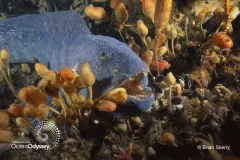Exploring a Unique Biodiversity Hotspot In the Gulf of Maine

Cashes Ledge is a wild, special place in the heart of the Gulf of Maine. This underwater mountain range is home to a great diversity of life, with colors typically associated with a coral reef rather than a cold, northern environment. Its steep peaks reach almost to the ocean’s surface—a fact that historically made Cashes Ledge a dangerous place for fishermen, who could easily snag and rip or lose their nets on the jagged underwater mountaintops. As a result, the thriving ecosystems on the Ledge have been relatively undisturbed by people for centuries. To promote the rebuilding of New England’s depleted groundfish populations including Atlantic cod, fishery managers closed Cashes Ledge and the area around it in 2002 to commercial bottom trawling and dredging – affording this special place some protection. Cashes Ledge provides scientists with a rare underwater laboratory to see into the past wildlife of the Gulf of Maine, observe changes in species abundance and distribution over time, and, increasingly, witness the impacts of humans and climate change on the marine environment.
As marine ecologist at Brown University, I have been studying Cashes Ledge for more than thirty years. For the past two years, National Geographic photojournalist Brian Skerry and I have led a team of scientists, photographers and videographers on a series of dive expeditions to document the ecological importance of Cashes Ledge and its impressive array of marine wildlife and seascapes. Our team set out to answer one question: why is Cashes Ledge so special? The answer to this question is simultaneously straightforward and multi-faceted.
The dramatic topography and dynamic ocean currents around the ledge create a unique environment where nutrient- and oxygen-rich waters mix while being exposed to sunlight. This creates ideal conditions for a spectacular array of diverse marine life. One can see whales (minke, right, humpback, pilot), basking sharks and Atlantic white-sided dolphins at the surface. In the mid-water column it is not unusual to see schools of herring, squid and bluefin tuna. Blue sharks may be seen at any depth, particularly toward the end of summer. Close to and on the seafloor of Cashes Ledge there are cod (including an unusual “red” cod), haddock, pollock, wolfish, big clusters of sea anemones, delicate feather stars called crinoids, and rare sponges and sea squirts typical of sub-arctic areas of Scandinavia. The average number of species of invertebrates, like sponges, sea anemones and mollusks, living on underwater cliffs is higher on Cashes Ledge than elsewhere at comparable depths in the Gulf of Maine.
The underwater landscape there isn’t all rocky ridge. Just like the lower slopes of a mountain range, there are boulder and cobble fields on the deep flanks of the ledge. These grade into sedimentary habitats of sand, gravel and mud where large tube anemones (Cerianthus sp.) and northern shrimp (Pandalus borealis) dot the deep landscape. Cashes Ledge also contains the largest and deepest continuous kelp forest in offshore waters of the eastern United States. It’s an incredibly productive ecosystem where the amount of kelp is hundreds of times more dense than what you would find at the same depth in coastal zones close to shore. Since the kelp is so dense at the bottom—40 plants per square meter on average—and large, it is dark under the canopy.
The kelp forest and the ledge itself provide many valuable goods and services to keep the offshore Gulf of Maine ecosystem healthy, vibrant, and productive. For example, we know from studies elsewhere that kelp detritus represents an energy-rich food source for marine life throughout the food web in habitats near and far. The kelp on Cashes Ledge acts as an ecosystem engineer by providing nursery habitat for many species, including commercially important fish such as Atlantic cod, pollock and the rare Atlantic wolfish, as well as a diverse array of invertebrates from mussels to shrimp.
Another reason why Cashes Ledge is so special traces back to our work in the 1980s, when we found that the Cashes Ledge ecosystem was like a time machine harking back to New England in the 1600s. Then, cod were so abundant that hook-and-line fishermen from England would fill up their boats with fish in several weeks. With time-lapse cameras and videos in the 1980s, we documented over 90 cod passing over a two-square meter area of seafloor in one hour on Cashes Ledge. In comparison, we saw no cod in an entire day or more at coastal sites where cod had been so abundant hundreds of years ago. Today, Cashes Ledge provides a refuge for cod which have been overfished throughout New England.
Cashes Ledge provides us with a view into what the past looked like, before humans touched all parts of the ocean. The biodiversity and productivity here make it a special place to visit, study and track through time.
Images from Brian Skerry









